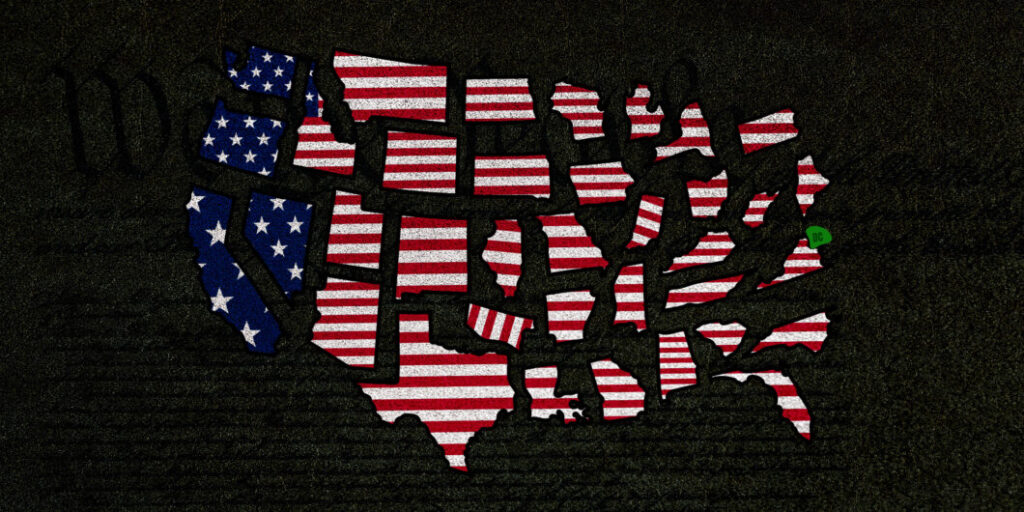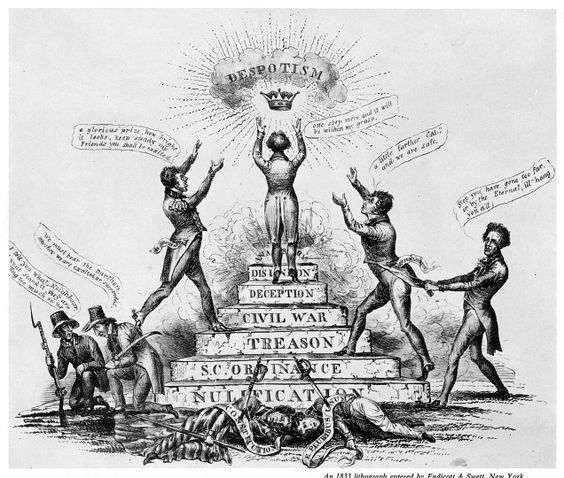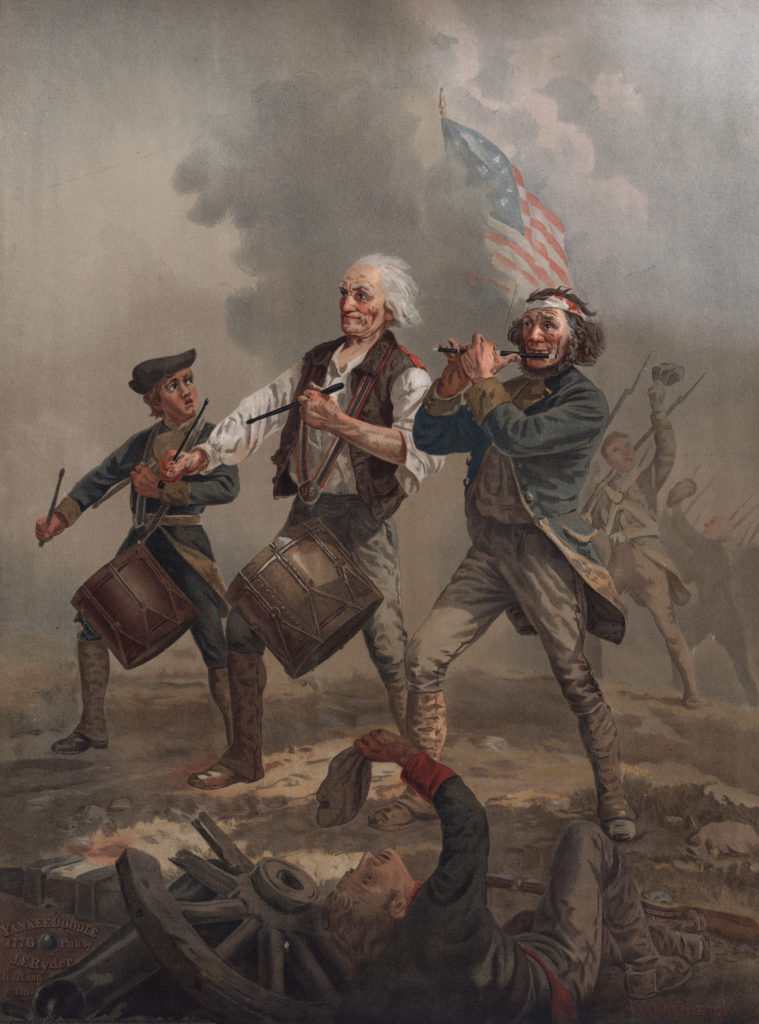The Union and its Discontents
Many Americans regard their national government as a hostile “regime.” In a republic, the solution is constructive civic engagement, not futile resistance—unless, of course, the goal is disunion.
This article first appeared in Law & Liberty on August 1, 2024 (here) as the lead essay in a Forum entitled “Nullification of the Constitution.” Thanks to Real Clear Policy (here), The Right Coast (here), and The Originalism Blog (here)! John Grove’s reply essay is here. Tom Woods featured my lead essay on the Tom Woods Show (here). Woods’ reply essay is here. Forrest Nabors’s reply essay is here. My friend William Watkins registers his respectful disagreement here. One critic of nullification has opined that “It’s constitutional nonsense–and a sure-fire indicator of a crackpot.” I try to avoid name-calling and ad hominem attacks, but one unhinged proponent of nullification illustrates the accuracy of the “crackpot” designation in an invective-filled, two-part diatribe (here and here). Spoiler alert: I’m accused of being “stupid,” “idiotic,” and writing an essay that is “embarrassingly bad,” “laughably bad,” and “really stupid.” Among other childish insults. Honorable mention in the witless name-calling category goes to the leaders of TN Citizens for State Sovereignty, who deem me a “constitutional illiterate” and a “judicial supremacist” (here). I plead guilty to attending law school and passing the bar, unlike some of my critics. Runner-up status goes to the Tenth Amendment Center, which peddles a fantasy version of the Constitution (here).
My debate with Jeff Cobble is here. Paul Gottfried’s take is here. Spoiler alert: Gottfried says that “Pulliam seems, in my view, to have the edge in this debate.” Law professor Nelson Lund offered some further thoughts (here).
My response to the forum is here.

In an era of norm-bending politics, it is no wonder that concerned citizens seek simple solutions to complex problems. On the right, some beleaguered conservatives have embraced the notion that the Constitution, properly understood, allows states unilaterally to nullify federal laws they believe to be unconstitutional. Proponents of this theory even claim that James Madison and Thomas Jefferson joined John Calhoun in supporting nullification! I addressed this topic in Law & Liberty a few years ago, but proponents of nullification continue to urge state legislatures to enact statutes to overturn federal laws (and judicial decisions) with which they disagree.
In recent decades, hundreds of “nullification” bills have been introduced in more than three-quarters of the states, many of them issue-specific protests against Obamacare, gun control, the Federal Reserve, regulation of raw milk, and other federal actions anathema to conservatives. I do not regard these measures as true examples of “nullification” because they are essentially statements of disagreement or vows of non-cooperation, rather than declarations of defiance in the name of state sovereignty. Only the latter rest explicitly on the claim that states are able to judge the constitutionality of federal laws—and to refuse to obey laws they deem to be contrary to the Constitution.
However, in some cases true nullification laws have been proposed, and even passed, creating a process for states to disregard federal laws if the state (generally acting through its legislature) finds the laws to be ultra vires, and therefore null and void. Utah recently enacted such a “Constitutional Sovereignty Act,” which could provoke a showdown with the federal government if and when a particular action is declared invalid by the Beehive State. Similar bills are pending in Missouri, Wyoming, and Tennessee.
My goal in this essay is to provoke an informed dialogue on an issue that has roiled the nation since the founding—the respective roles of the federal and state governments in interpreting the Constitution.

A. What Is Nullification?
“Nullification” is used imprecisely to refer to many different things, not all of which are controversial. Resolutions by state officials expressing opposition to particular federal laws, declarations of non-cooperation (such as cities proclaiming themselves “sanctuaries” for illegal aliens), and even enacting state laws permitting the sale and use of controlled substances banned by federal law are permissible because states cannot be compelled to enforce federal laws. Federalism forbids the national government to “commandeer” state resources to enforce federal law. This dates back to the antebellum Supreme Court decision in Prigg v. Pennsylvania (1842). Neither, however, can states interfere with the enforcement of federal law or unilaterally override the federal courts’ interpretation of the Constitution and federal statutes, contrary to the Constitution’s Supremacy Clause.
Proponents of nullification tend to conflate the foregoing actions without distinguishing among them, envisioning statements of protest, Second Amendment sanctuaries, withholding state funds, and outright defiance. The proposed Tennessee bill that I am most familiar with (S.B. 2775) is broad enough to cover all these forms of “nullification.” My objection is limited to the notion that state officials have the authority to declare federal actions (laws, regulations, policies, and court decisions) “null and void” if the state deems them unconstitutional. S.B. 2775 decrees that nullified laws “must be resisted.” The proposed Tennessee bill even empowers state judges to ignore controlling federal precedents (including Supreme Court decisions) as they see fit. Imagine a jurisprudential Tower of Babel!
The brand of nullification peddled by proponents such as the John Birch Society, the Tenth Amendment Center, and libertarian author Thomas Woods is not limited to protests and non-cooperation. It amounts to full-blown resistance to the federal government, presuming that the states are not bound by federal laws they consider to be unconstitutional. This form of nullification, which emasculates the Supremacy Clause, is secession-lite. In fact, one representative article in JBS’s The New American is titled “Secession? Why Not Nullification?” This misguided argument undermines our union and misreads the Constitution.
B. The Origins of the Constitution
We must begin this inquiry prior to the enactment of the Constitution, by looking to the document that served as our nation’s charter for nearly a decade following the Declaration of Independence—the Articles of Confederation. The Articles established something short of a national union in the modern sense; the original 13 states described their bond as a “confederacy” and a “firm league of friendship with each other.” This loose relationship preserved the states’ sovereignty by creating a weak national government that lacked both an executive and a judicial branch, conferred no authority to levy federal taxes or regulate interstate commerce, required unanimity for altering the Articles, and operated via a unicameral legislature in which all 13 states had a single vote, regardless of population.
Under the Articles, the central government was extremely limited, facing great difficulty funding the Revolutionary War and suppressing insurrections such as Shay’s Rebellion in 1786-87. A nation powerless to enforce its decisions is not truly a nation. When the founders convened in Philadelphia in the summer of 1787, they realized that a stronger national government was required to preserve the union. The challenge was to create something for which there was no precedent: a dual system of sovereignty in which the states continued to function as political entities, simultaneously with a newly-created “federal” (or national) government that possessed central powers that the Articles withheld.
The document that emerged from the Constitutional Convention was fully ratified in 1789 and was soon accompanied by a Bill of Rights, which were ratified in 1791. The Constitution was the subject of contentious debates—during and after the convention—about how the novel arrangement would work, and whether the expanded national government would impinge on state prerogatives. The Constitution, as drafted, represented a compromise, which by definition does not perfectly satisfy any faction. The Federalist Papers were written to convince the states to ratify the Constitution, and the Anti-Federalists reciprocated with counter-arguments. Ultimately, the Federalists prevailed, but many present-day concerns about the potential abuses of the national government were presciently foreshadowed in the ratification debates.
The issue, in a nutshell, is who has ultimate authority to determine the validity of federal laws. Dual sovereignty does not connote parity; the union, once formed, must be paramount. All three branches of the federal government (and, pursuant to the Supremacy Clause, the states) are subject to the Constitution, which is interpreted by the aptly-named Supreme Court. Over the past 230 years, states have quarreled with various actions of the federal government, and on occasion have disagreed with particular Supreme Court decisions. The conventional understanding is that states cannot, despite their disagreement, simply ignore, or defy, federal laws. This would render the union nugatory, and in extreme form lead to secession.
Nullification proponents dispute this conclusion, claiming that Article VI, clause 2 limits supremacy to federal laws enacted in accordance with the Constitution; in other words, states are free to make their own determination of constitutionality, and to pick and choose which laws to obey accordingly. Proponents of nullification also place great emphasis on the 10th Amendment (which merely states that authority not ceded to the federal government in the Constitution is retained by the states), ignore numerous controlling Supreme Court precedents with which they disagree, and selectively rely on fragments of American history (and quotes from various figures in the founding era) to justify the notion that states can choose to ignore the provisions of federal law by deeming them to be extra-constitutional.
This makes a mockery of the union, and would take the nation back to the dysfunctional Articles that were abandoned (with good reason) over two centuries ago. Proponents of nullification invariably cite the same “evidence” in support of their position. Let us briefly consider the extended history of this misguided theory.
C. Kentucky and Virginia Resolutions
In the fractious early days of the republic, the Federalist Party held the White House (President John Adams) and controlled Congress. Motivated by conflicts with France that might lead to war (and which some historians refer to as a “quasi-war”), the Federalists passed the draconian Alien and Sedition Acts of 1798 to suppress political dissent. The Acts (and in particular the Sedition Act) were very unpopular, especially in the opposition party led by Thomas Jefferson, the Republicans. The Supreme Court had not yet established the doctrine of judicial review, pursuant to which laws can be challenged on appeal on the ground they violate the Constitution. This did not happen until 1803 in Marbury v. Madison. The federal judiciary was still in an embryonic stage. Accordingly, two prominent Republicans, Jefferson and James Madison, ghost-wrote vehement protests of the Alien and Sedition Acts, contending that the laws were unconstitutional. In 1798, these protests were adopted by the legislatures of Kentucky and Virginia, respectively.
Scholars speculate that the true motivation for these resolutions was political—to foment opposition to the Federalists and their policies. The resolutions were largely ineffective. No other states passed similar resolutions, many rejected them, and several even wrote resolutions opposing the right of states to declare federal statutes null and void. The Kentucky and Virginia Resolutions had no legal effect whatsoever. Eventually, the unpopularity (and partisan abuses) of the Alien and Sedition Acts led the Federalists to lose power. Jefferson was elected President in 1800, and Congress allowed the unpopular law to expire. Those convicted of sedition under the Act were pardoned.
In the Virginia Resolution, Madison did not claim that states could unilaterally strike down federal laws. It was simply the expression of protest by the Virginia legislature. Madison used the term “interposition” rather than “nullification.” In response to the counter-resolutions of other states opposing the doctrine of nullification, in the 1800 Report of Virginia House of Delegates, Madison made it clear later that he did not believe the states had the unilateral authority to invalidate federal laws because of their purported unconstitutionality. The 1800 Report, described by one scholar as Madison’s “line by line” analysis of the Virginia Resolution, clarified that “interposition” by states is appropriate only in cases of usurpations “deeply and essentially affecting the vital principles of” the Constitution, and concluded that the Virginia Resolution was merely an “expression of opinion” designed to spur debate. These views are consistent with an 1830 letter that Madison wrote to Edward Everett, contained in the National Archives.
Later, in the wake of the Nullification Crisis (discussed below), Madison made his views unequivocally clear in 1834:
But it follows from no view of the subject, that a nullification of a law of the United States can, as is now contended, belong rightfully to a single State, as one of the parties to the Constitution; the State not ceasing to avow its adherence to the Constitution. A plainer contradiction in terms, or a more fatal inlet of anarchy cannot be imagined. (Emphasis added.)
Jefferson, whose nullification rhetoric was more aggressive than Madison’s—bordering on advocacy of secession–played no role in the drafting of the Constitution, and was not even in the United States when the Constitutional Convention was held in 1787. (Jefferson was abroad, serving as the minister to France.) One of his biographers, Dumas Malone, argued that Jefferson—then Vice President–concealed his authorship of the Kentucky Resolution because he feared it would be considered seditious or even treasonous. Therefore, Jefferson’s anonymously-authored views regarding the Constitution must be assigned little weight.
Nullification proponents risibly claim that the Kentucky and Virginia Resolutions “prove” that the framers supported nullification, but the actual history obviously shows otherwise.
D. Nullification Crisis in 1832-33
The next milestone in the history of nullification occurred in 1832-33. Historians refer to this episode as the Nullification Crisis of 1832-33. Before the authorization of a federal income tax in the 16th Amendment (ratified in 1913), federal revenues were generated mainly by charging tariffs on imported goods. Tariffs were unpopular in the South, which depended on the export of cotton, tobacco and other goods. The imposition of high tariffs to protect northern manufacturers invited retaliation by European nations who purchased southern goods.
John C. Calhoun, from South Carolina, objected to the Tariff of 1828 and asserted that each state has the right to “veto” federal laws if the state believes it encroaches on its rights. (Famed 19th century lawyer and statesman Daniel Webster, disagreed.) In 1832, South Carolina undertook to nullify the tariff and prohibit its enforcement within the state.

President Andrew Jackson denied that South Carolina had the power to nullify federal statutes and threatened to use federal troops to put down any attempt to interfere with the tariff as an act of rebellion—treason, he called it. To Jackson, nullification was tantamount to secession, a result Jackson would not countenance. In President’s words:
I consider, then, the power to annul a law of the United States, assumed by one State, incompatible with the existence of the Union, contradicted expressly by the letter of the Constitution, unauthorized by its spirit, inconsistent with every principle on which It was founded, and destructive of the great object for which it was formed. (Emphasis added.)
South Carolina backed down, and a compromise was reached on the tariff, averting a crisis. The seeds of states’ rights rhetoric planted by Calhoun germinated into full-blown secession in 1860, when South Carolina was the first state to leave the union, leading to the bloodiest war in our history.
E. Slavery and the Fugitive Slave Act
Prior to the Civil War, and enactment of the 13th Amendment, the institution of slavery led to many legal conflicts, especially when non-slave states attempted to interfere with the enforcement of the federal Fugitive Slave Acts of 1793 and 1850. In Prigg v. Pennsylvania (1842), the Supreme Court rejected Pennsylvania’s attempt to nullify the Fugitive Slave Act of 1793. In Ableman v. Booth (1859), the Supreme Court rejected Wisconsin’s attempt to nullify the Fugitive Slave Act of 1850 and to prevent the federal courts from reviewing state court decisions or enforcing federal law.
Because the “natural law” argument for nullification is similar to the one asserted in support of secession, the defeat of the Confederacy in the Civil War was thought to resolve the question once and for all. As it turns out, nullification was to resurface for an unsuccessful encore in the 20th century.
F. Desegregation
The most recent—and most emphatic—rejection of the nullification doctrine came as a result of intense southern opposition to the Supreme Court’s desegregation decision in Brown v. Board of Education (1954). Brown was a very controversial decision in its day, eliciting more criticism than any other Supreme Court decision of the 20th century. Many southern states were engaged in “massive resistance” to judicial orders to de-segregate schools and other public institutions.
In 1957, public opposition to court orders requiring the integration of Central High School in Little Rock, Arkansas, emboldened by the resistance of Arkansas Governor Orval Faubus, led to mobs seeking to prevent the enrollment of black students at the previously all-white school. Faubus even deployed the Arkansas National Guard to prevent enforcement of the federal court order. In response, President Eisenhower invoked the Insurrection Act of 1807 to enable troops to perform domestic law enforcement, and ordered federal troops (the 101st Airborne Division of the United States Army) to Little Rock to ensure that federal court orders were complied with.
Arkansas’s open defiance did not go unnoticed in the Supreme Court. In 1958, the Court issued its decision in Cooper v. Aaron, a lawsuit filed by members of the Little Rock School District trying to avoid compliance with the desegregation order. The Supreme Court’s decision was unanimous, and—without precedent—signed by all nine Justices. The Supreme Court rebuked the recalcitrant officials and proclaimed that its interpretation of the Constitution is final and binding. Cooper v. Aaron announced the doctrine of judicial supremacy:
Article VI of the Constitution makes the Constitution the “supreme Law of the Land.” In 1803, Chief Justice Marshall, speaking for a unanimous Court, referring to the Constitution as “the fundamental and paramount law of the nation,” declared in the notable case of Marbury v. Madison, 1 Cranch 137, 5 U. S. 177, that “It is emphatically the province and duty of the judicial department to say what the law is.” This decision declared the basic principle that the federal judiciary is supreme in the exposition of the law of the Constitution, and that principle has ever since been respected by this Court and the Country as a permanent and indispensable feature of our constitutional system.
The same scenario was repeated in Mississippi in 1962, when President Kennedy sent federal troops to Oxford, Mississippi to quell a riot and overcome public and political resistance to the integration of the University of Mississippi pursuant to federal court orders.
The following year, 1963, when Alabama Governor George Wallace stood in the schoolhouse door to prevent black students from enrolling at the University of Alabama, President Kennedy federalized Alabama National Guard troops to force Wallace to halt his blockade and submit to a judge’s order ending segregation at the university. Later in 1963, the process was repeated to ensure compliance with a federal court order to integrate Tuskegee High School in Alabama.
G. Nullification Is Incompatible with the Union
Nullification proponents often contend that the Supreme Court has overridden or usurped the “true meaning” of the Constitution, rendering the Court’s decisions “null and void.” There are several responses to this charge. Whether one agrees or disagrees with a particular Supreme Court decision, one has to concede that the judicial branch was designed to interpret the law, including resolving conflicts between statutes and the Constitution. That is what courts do. The Marbury v. Madison precedent from 1803 recognized that the Supreme Court has the power of judicial review, consistent with Alexander Hamilton’s Federalist 78. The Supremacy Clause states that federal law “shall be the supreme Law of the Land,” and “the Judges in every State shall be bound thereby, any Thing in the Constitution or Laws of any State to the Contrary notwithstanding.” Art. VI.
If the Supreme Court is not the ultimate authority in disputes involving interpreting the Constitution, the national government created by the Constitution drafted in Philadelphia in 1787 would be subject to the same flaws that doomed the Articles of Confederation: the lack of a meaningful central government. As Justice Joseph Story wrote in 1840, without the judicial power created in Article III, “the laws of the Union would be perpetually in danger of being contravened by the laws of the States. The National Government would be reduced to a servile dependency upon the latter for the due execution of its powers.” Regarding the Supremacy Clause, Story had this to say: Allowing states to second guess the validity of federal laws “would be a solecism, so mischievous, and so indefensible, that the scheme could never be attributed to the framers of the Constitution, without manifestly impeaching their wisdom, as well as their good faith.” Indeed, it would reduce the national government to “an idle mockery.”
Finality in constitutional interpretation is critically important because the generality of key constitutional provisions makes good faith disagreement possible. Many nullification proponents believe that the Court has allowed the federal government to exceed the limited powers enumerated in Art. I, section 8. However, reasonable people can come to different conclusions regarding the meaning of phrases such as “general welfare,” “necessary and proper,” and “regulate commerce.” If the Court has made errors in interpreting the Constitution, those errors began more than 200 years ago. The most momentous decision in this regard is McCullough v. Maryland (1819), which unanimously held that Congress has implied powers not expressly enumerated in Art. I, section 8.
While I do not necessarily agree with all the Supreme Court decisions disputed by nullification proponents, one must acknowledge that prior to its ratification the Anti-Federalists warned that the Constitution could—and would—be interpreted in that manner. In any event, the mechanism for correcting an erroneous constitutional interpretation is to amend the Constitution through Article V, or litigation, not nullification by the states.
Nullification proponents refuse to face the fact that the doctrine of nullification has never worked in America. Not in 1798, not in 1832-33, not in the run-up to the Civil War, and not in opposition to Brown. Nullification is illusory—a chimera. It is a fantasy that ignores 230 years of history, controlling Supreme Court precedents, and the plain meaning of the Supremacy Clause of the U.S. Constitution.
One constitutional scholar has stated that “If you believe in nullification, you don’t believe in the Constitution.” This formulation, while provocative, reflects the consensus of mainstream legal thought, even in conservative circles (e.g., Mark Levin, John Eastman, David Barton, the Heritage Foundation, Cato Institute, Americans for Limited Government, Convention of States, Rob Natelson).
Nullification is an untenable theory. As libertarian law professor Randy Barnett has said, “Political activists should not waste their precious energies on sketchy constitutional theories such as the assertion of a state power to nullify unconstitutional laws that, for better or worse, have long been rejected by the Supreme Court–as Wisconsin’s was in Ableman v. Booth–that five justices certainly would not today support, and that rest on dubious claims about original meaning.”
The dual sovereignty of our unique federal system often leaves the precise demarcation of “states’ rights” uncertain, or subject to disagreement. Citizens dissatisfied with perceived federal encroachment should resort to the tools of democratic self-government—protests, state and federal political activism, the Article V amendment process, or legal challenges—–not the lazy and unavailing “solution” of nullification.

































